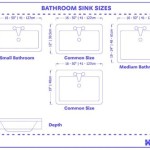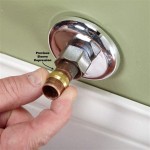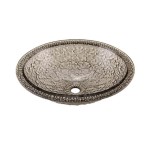Sea Blue Glass Tile Backsplash: Elevating Bathroom Aesthetics
The bathroom, often considered a sanctuary for relaxation and personal care, benefits significantly from thoughtful design choices. A sea blue glass tile backsplash can transform this space, injecting a sense of tranquility and sophistication. The color blue, particularly shades reminiscent of the ocean, is inherently calming, while the reflective properties of glass enhance the room’s luminosity and create an illusion of spaciousness. This article delves into the multifaceted benefits, design considerations, installation nuances, and maintenance aspects of incorporating sea blue glass tiles into a bathroom backsplash.
The Allure of Sea Blue: Color Psychology and Design Harmony
Color psychology plays a crucial role in interior design. Sea blue, a versatile shade derived from the spectrum of blue, evokes feelings of serenity, stability, and harmony. Its association with the ocean and sky connects individuals to nature, promoting a sense of peace and well-being. In a bathroom setting, this calming effect can be particularly beneficial, creating a relaxing environment for unwinding after a long day or preparing for a fresh start in the morning. Beyond its psychological impact, sea blue harmonizes well with a variety of color palettes and design styles. It complements neutral tones such as white, beige, and gray, creating a balanced and sophisticated look. It also pairs beautifully with natural materials like wood and stone, adding warmth and texture to the space. For those seeking a more vibrant aesthetic, sea blue can be combined with pops of brighter colors like coral, yellow, or green, creating a visually stimulating and energetic atmosphere.
The versatility of sea blue extends to its ability to adapt to different design styles. In a coastal-themed bathroom, sea blue glass tiles can be used to create a backsplash that mimics the shimmering surface of the ocean, complementing elements like seashells, driftwood, and nautical decor. In a minimalist bathroom, the clean lines and reflective surface of glass tiles can enhance the simplicity of the design, while the calming hue of sea blue adds a touch of sophistication. In a more traditional bathroom, sea blue can be paired with classic fixtures and finishes, creating a timeless and elegant look. The choice of grout color can also significantly impact the overall aesthetic. A light-colored grout will emphasize the individual tiles and create a more mosaic-like effect, while a darker grout will create a more seamless and uniform appearance.
Material Advantages: Durability, Maintenance, and Visual Appeal
Glass tiles offer a range of practical advantages that make them an excellent choice for bathroom backsplashes. One of the primary benefits is their inherent durability. Glass is a non-porous material, meaning it is resistant to water absorption, staining, and mildew growth. This is particularly important in a bathroom environment, where humidity and moisture are prevalent. Unlike other materials like natural stone or ceramic, glass tiles do not require sealing, simplifying maintenance and ensuring a long-lasting and hygienic surface. The non-porous nature of glass also makes it easy to clean. A simple wipe down with a mild detergent and water is typically sufficient to remove soap scum, water spots, and other common bathroom grime.
In addition to their durability and ease of maintenance, glass tiles offer exceptional visual appeal. The reflective surface of glass enhances light diffusion, making the bathroom appear brighter and more spacious. This is particularly beneficial in smaller bathrooms or those with limited natural light. The transparency of glass also allows for a wide range of color variations and effects. Sea blue glass tiles can be manufactured in a variety of shades, from light and airy aquamarine to deep and saturated cobalt, allowing for customized design options. Furthermore, glass tiles can be textured or patterned to add visual interest and depth. Options include frosted glass, textured glass, and glass tiles with embedded patterns or metallic accents. The combination of color, reflectivity, and texture creates a backsplash that is both functional and aesthetically pleasing. The cost of glass tile can vary depending on the size, shape, and complexity of the design. While glass tiles may be more expensive than some other backsplash materials, their durability, ease of maintenance, and visual appeal make them a worthwhile investment in the long run.
Installation Considerations: Preparation, Techniques, and Sealing
Proper installation is crucial for ensuring the longevity and aesthetic appeal of a sea blue glass tile backsplash. The first step is thorough surface preparation. The wall must be clean, dry, and free of any loose paint, wallpaper, or debris. Any imperfections, such as cracks or holes, should be repaired before beginning the tiling process. Applying a waterproof membrane to the wall behind the backsplash is essential in a bathroom environment. This membrane will prevent water from seeping behind the tiles and causing damage to the wall structure. Once the wall is prepared, the next step is to apply a thin-set mortar specifically designed for glass tiles. This type of mortar typically has a higher polymer content, which provides better adhesion and flexibility, reducing the risk of cracking. The mortar should be applied evenly to the wall using a notched trowel, creating ridges that allow the tiles to bond securely.
When laying the tiles, it is important to use spacers to ensure uniform grout lines. Glass tiles are often available in various shapes and sizes, including square, rectangular, and mosaic patterns. The chosen tile pattern will influence the overall aesthetic of the backsplash. After the tiles have been laid and the mortar has dried, the next step is to grout the joints. Use a non-sanded grout specifically designed for glass tiles to avoid scratching or damaging the surface. Apply the grout evenly, pressing it into the joints to ensure complete coverage. After the grout has dried slightly, use a damp sponge to remove any excess grout from the tile surface. Allow the grout to cure completely before sealing it with a grout sealer. This will help prevent staining and mildew growth. Although glass tiles are non-porous, sealing the grout lines is essential for maintaining a clean and hygienic backsplash. Cutting glass tiles can be challenging and requires specialized tools. A wet saw with a diamond blade is recommended for making clean and precise cuts. If you are not comfortable cutting glass tiles, it is best to hire a professional installer.
Lighting plays a critical role in showcasing the beauty of a sea blue glass tile backsplash. Consider installing under-cabinet lighting to illuminate the backsplash and highlight its reflective qualities. Recessed lighting can also be used to create a soft and ambient glow. The type of lighting fixture and the color temperature of the bulbs can significantly impact the overall aesthetic of the bathroom. Warm lighting can create a cozy and inviting atmosphere, while cool lighting can enhance the vibrancy of the sea blue tiles.

Natural Sea S In Blue Glass Mosaic Tiles 12x12 Wall And Floor Tile For Bathroom Kitchen Backsplash Us 239 99 Bể Bơi Gạch

Tst Glass Conch Tiles Beach Style Sea Blue Tile Green Mosaics Wall Art Kitchen Backsplash Bathroom Design Blujellyfish

Apollo Tile Sea Blue 11 9 In X Polished Glass Mosaic 4 92 Sq Ft Case Aplbr88042a The Home Depot

Tst Glass Conch Tiles Beach Style Sea Blue Tile Green Mosaics Wall Art Kitchen Backsplash Bathroom Design Blujellyfish

Glacier Sea Blue 3 Glass Subway Tile Colored Wall Tiles

8 9 X Sea Glass Louvre Blue Mosaic Tile Club

Ocean Blue Bathroom Backsplash Tiles Design Ideas
-800x800.JPG?strip=all)
Tst Glass Conch Tiles Sea Blue Wall Tile Ocean Mosaic Mother Of Pearl For Bathroom Shower

13 Baths Tiled In Beautiful Sea Glass Blue

Tesoro Blue Wave Glass Tile Mosaic Tiles






